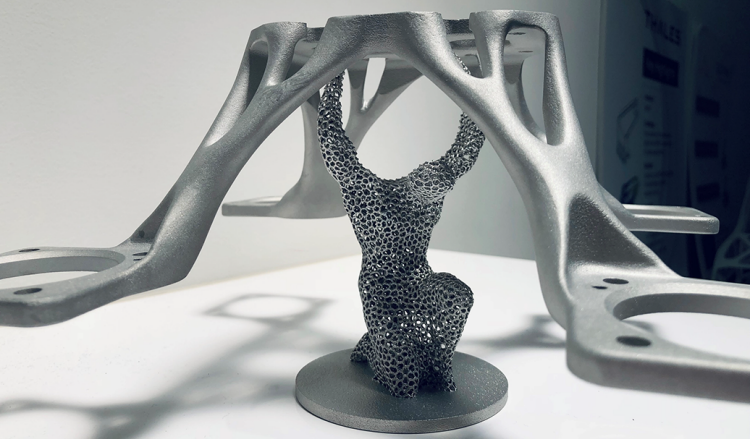An optimal additive manufacturing environment

Additive manufacturing (AM) is not solely a manufacturing process, nor is it a new methodology for designing optimized components. Additive is the perfect example for cross domain engineering, getting the right product and making it right requires accurate communication between design and manufacturing. Multi-input optimization is almost synonymous with additive and that is most clearly seen in the aerospace industry, where the technology is revolutionizing aircraft development. Companies looking for better systems, are finding geometric optimizations for better weight characteristics, aero and hydrodynamic efficiencies, and even thermal performance. But making that viable also requires optimization with manufacturing process and of manufacturing workflows.
Optimized parts
Making an optimized part is different for almost every industry and even applications within them, which makes it difficult to speak in specific terms without boring at least one group. But in simplest terms, optimized parts made with additive manufacturing add performance, decrease costs, balance competing requirements, or any combination thereof. Looking at making a component or system more sustainable with AM, may initially require an optimization of improved performance over costs – be they material, time, quality, or capital. There are many optimizations that rely on system usage in the real world through a comprehensive simulation environment and there are others that connect design to the production to ensure improvement gains through design are not negated by manufacturing decisions later. If a custom run part needs to be reprinted due to a predictable manufacturing defect, that immediately doubles the material and emissions cost of that component. Without insight to the entire process, an optimized part can fail requirements.
Optimized production
Implementing AM successfully also requires an optimized production environment, and this need only grows with scale. For a company like Morf3D, designing at printing facility at scale requires two keys – an expansive library of machines, capabilities, and installation requirements as well as a comprehensive software portfolio to plan operations around this intelligence. Partnerships and first-hand experience of the Siemens service business provide users with access to loads of data on individual AM machines to find the right fir for their application, whether it is for large-format printing for aerospace or fine titanium alloy structures for medical applications. Then by combining this wealth of information with the requirements to manufacturing, the floor plans, machine selection, and much more can be optimized in software. Material flows through production can be planned, validated, and iterated to find the best and most efficient path – minimizing time, energy, and risk/unknowns.
Optimizing the future
Designing an optimal product and manufacturing it optimally are great, but a successful business functions on growth in most cases. Fortunately, by setting up the digital infrastructure for optimized parts and production in the beginning, a business can continually iterate on all of the processes as more information becomes available or new technologies emerge. For example, lifecycle information on products in the field guide updates to development, possibly through part improvements or maybe process alterations that impact material properties. Historical information provides context for new data and wider data sets improve the ability to optimize based on the product requirements. This data collection and foresight is important as new technologies are adopted to reduce the learning curve of the new processes. A printer with a larger print volume may be slightly different from previous machines, but the refined digital environment makes validating the processes that much easier.
Making a future in AM possible
Additive manufacturing is not just a valuable tool to manufacturing, but a new mindset to how to design products. That makes for a greatly expanded design space, but it also creates unknowns in product development in both design and manufacturing. Using a digital first approach to AM helps fill in the holes that exist in a business, using simulation and organizational rigor to find the best solutions for a given task. And by implementing these workflows early, more optimized solutions can be found – not just local perfections, but global ones. As a business continues to nurture the AM process, the future of development will continue to grow, to new technologies, new techniques, and more sustainable processes. For more information on how Siemens is helping companies meet these goals, from software to hardware and everything in between, check out this story on Morf3D’s experience.
Siemens Digital Industries Software is driving transformation to enable a digital enterprise where engineering, manufacturing and electronics design meet tomorrow. Xcelerator, the comprehensive and integrated portfolio of software and services from Siemens Digital Industries Software, helps companies of all sizes create and leverage a comprehensive digital twin that provides organizations with new insights, opportunities and levels of automation to drive innovation.
For more information on Siemens Digital Industries Software products and services, visit siemens.com/software or follow us on LinkedIn, Twitter, Facebook and Instagram.
Siemens Digital Industries Software – Where today meets tomorrow


